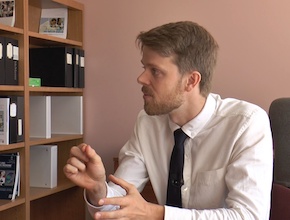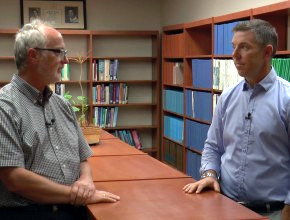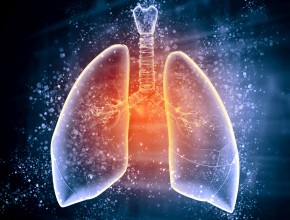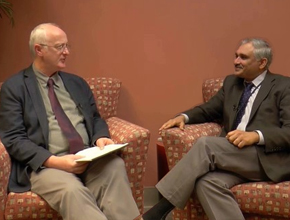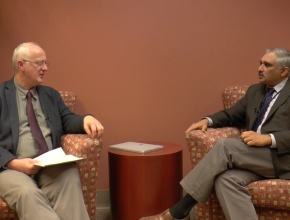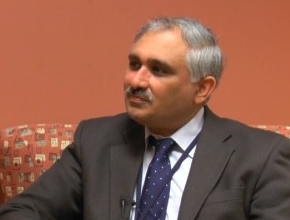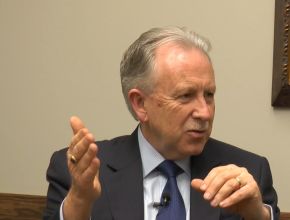References
Reddel HK, Busse WW, Pedersen S, et al. Should recommendations about starting inhaled corticosteroid treatment for mild asthma be based on symptom frequency: a post-hoc efficacy analysis of the START study. Lancet. 2017 Jan 14;389(10065):157-166. doi: 10.1016/S0140-6736(16)31399-X. PubMed PMID: 27912982.Roman Jaeschke: Good afternoon, welcome to another edition of McMaster Perspective. I would like to reintroduce to you Professor O’Byrne, our Dean of the Faculty of Health Sciences [at McMaster University]. I was quite surprised to see recently an article coming from a study I know you were involved with good several years ago. I wonder if we could start by talking a little bit about that particular study.
Paul O'Byrne: Certainly. The study you refer to is a study called the START trial, which was a large double-blind randomized comparison of low-dose once-daily inhaled corticosteroids in children, adolescents, and adults with newly diagnosed asthma – asthma diagnosed within one year of randomization – to evaluate the benefits of early introduction with inhaled corticosteroids on asthma and its severity and development of fixed airflow obstruction in patients with asthma. The study was done because of a number of smaller – some observational – studies that suggested that early intervention with low-dose inhaled corticosteroids provided clear benefit, particularly in children, when compared to delaying introduction for several years. The benefit was seen predominantly in reduced risk of a very severe asthma exacerbation, which required hospitalization, intubation, intensive care management, or hospital admission, as well as in reducing the risk of exacerbations that require oral corticosteroids, prednisone, but are managed in the out-of-hospital setting. The risk reduction was about 50% with once-daily steroids versus a placebo. The number needed to treat in that study to reduce one severe exacerbation of asthma needing prednisone was 30 patients treated for 1 year.
RJ: [A 50% reduction across the range of severities]?
PO: Yes, exactly. The other important result from that study was that we demonstrated that patients who had a severe exacerbation of asthma had a decline in lung function, postbronchodilator FEV1, which was the measurement used, that persisted for the remaining part of the study; it did not recover. That loss in lung function was seen but only in the patients treated with placebo, not in those treated with budesonide.
The conclusions were that there were two important outcomes with low-dose inhaled steroid used early in asthma: you reduce the risk of a severe exacerbation but you also reduce the consequences of that exacerbation, which was its effect on lung function.RJ: However rare these exacerbations were, they seem to be important beyond the period when the lung function was decreased. It persisted, did not recover. That is important, I think. So what generated the impetus to write the new paper and what did it show us?
PO: Because it was a large study, in the trial there were patients enrolled who had very frequent asthma symptoms; that was measured over a 2-week run-in period prior to randomization. There were patients with very infrequent symptoms, 0 to 1 days per week over those 2 weeks, and there were some patients with more frequent symptoms, greater than 2 days per week over the 2-week period.
RJ: And they were still classified as mild asthma?
PO: All mild, yes. In the current treatment recommendations for asthma, it is fairly consistent in all recommendations that if you have symptoms for 2 days a week or more, the recommendation would be to start inhaled corticosteroids, low doses of inhaled steroids. Of course, if the effect of budesonide as early intervention is measured in that population which we had in the START trial, it is a very clear benefit as measured by reduced exacerbations and courses of prednisone. The question in this most recent study was, could we also see that in people with even less frequent symptoms in the run-in period – if you like, the mildest of the mild patients. An analysis was done of 3 groups whose baseline symptoms in run-in were either 0 to 1 day a week over that 2-week period, 1 to 2 days a week over that period, or greater than 2 days a week. When the effect on the severe asthma-related events or courses of oral prednisone was evaluated, it was quite consistent across those patient populations, about a 50% reduction.
RJ: In each stratum?
PO: In each stratum about a 50% reduction with the low-dose once-daily steroid versus placebo. What this reanalysis has done is to indicate that we can demonstrate efficacy in everybody with asthma with once-daily low-dose inhaled steroids, even those with the mildest asthma you could possibly describe in a clinical trial; newly diagnosed symptoms one day a week or less. We can say with confidence now that the steroid will work in essentially everybody who has a confirmed diagnosis of asthma. The question is whether it is worth it, because in the mildest population these events were quite infrequent. In the slightly more symptomatic patients, they were about twice as frequent and so you can think at least in trying to understand the implications of this trial that for patients with more frequent symptoms, twice a day or more, there is now good justification for the guidelines recommending low-dose inhaled steroid monotherapy, but it also answers a question that we are asked all the time: why are not inhaled steroids used in everybody with asthma? We know everybody has inflammation, we know that even the mildest patients are at risk of exacerbations, albeit infrequent, and even at risk of asthma deaths, although again that is quite infrequent, and now we have got data to say that yes, we can demonstrate efficacy, but whether in fact the practical implications are that everybody will use inhaled steroids is quite different.
RJ: What would you suggest to somebody coming to your practice?
PO: What I will say now because of the data we have is that I am now confident that in every person with a diagnosis of asthma, inhaled steroids are beneficial, first of all. And secondly, that avoiding severe exacerbations is a worthwhile outcome because they are at risk – patients are at greatest risk during that time – and we know also from the START data I have already told you about that even one severe exacerbation changes lung function for, we think, the rest of that patient’s life. So avoiding that is a benefit. Of course, the patient must decide at the end of the day whether that benefit is worth the effort of using inhaled corticosteroids every day, which is what would be needed to get this benefit, at least as measured in a clinical trial, and the likelihood of adherence to that treatment regimen. As a consequence of those concerns, there are now a number of large clinical trials, which actually will be finished later this year, in 2017, that are looking at a slightly different approach, which is using a combination inhaler that contains an inhaled steroid with a long-acting beta-agonist, but in patients with mild asthma to be used only when the patient is symptomatic. That will get around the adherence issue and it will still ensure that when patients are symptomatic, even once or twice a week or whatever the rate of symptoms is, they are getting some inhaled steroids.
RJ: They have access to it right away.
PO: Exactly.
RJ: So starting bronchodilator as-needed (PRN) treatment with steroids at the same time.
PO: Absolutely.
RJ: OK. How low is the low dose?
PO: In the START trial, in children it was 200 mcg once daily of budesonide and in adults it is 400 mcg once daily. This is still an important issue because in the children height, or growth velocity, was measured consistently through the study and even that low once-daily dose of inhaled steroid did have a highly statistically significant effect on growth velocity.
RJ: How much?
PO: Half a centimeter over the 3 years. Sorry, I beg your pardon, let me restate that, that is not quite correct: 0.5 of a centimeter the first year, half of that the second year, and 0 the third year. So the entire effect was seen mainly in the first year. We also know from follow-up studies in children treated with steroids that asthmatic children on inhaled corticosteroids do reach their predicted final height; they just grow a little longer. So I do not feel it is a reason not to use steroids, but of course parents may feel differently, [because of] the fact that their child’s growth velocity is slightly affected by even these low doses.
 English
English
 Español
Español
 українська
українська

